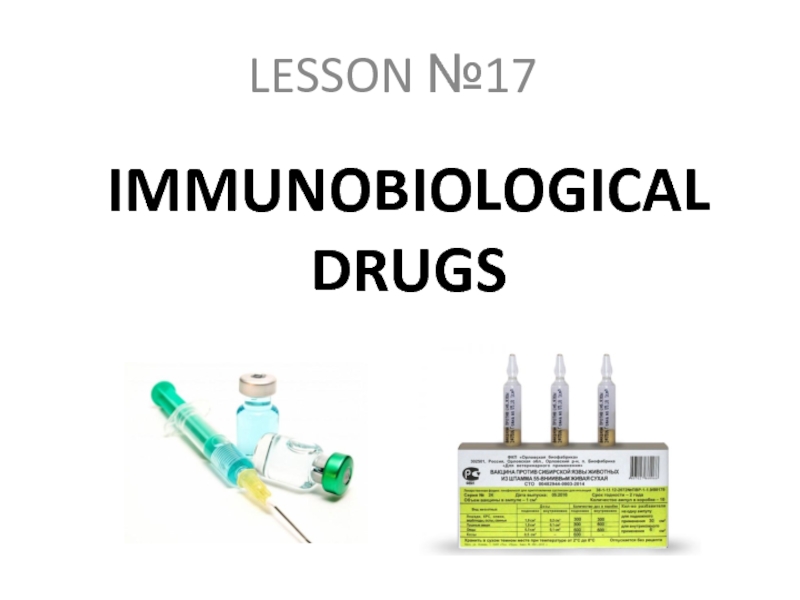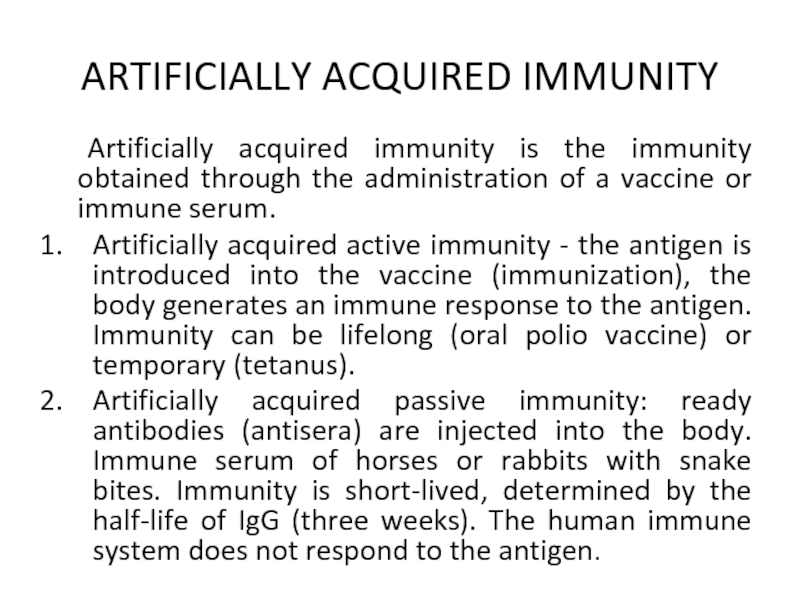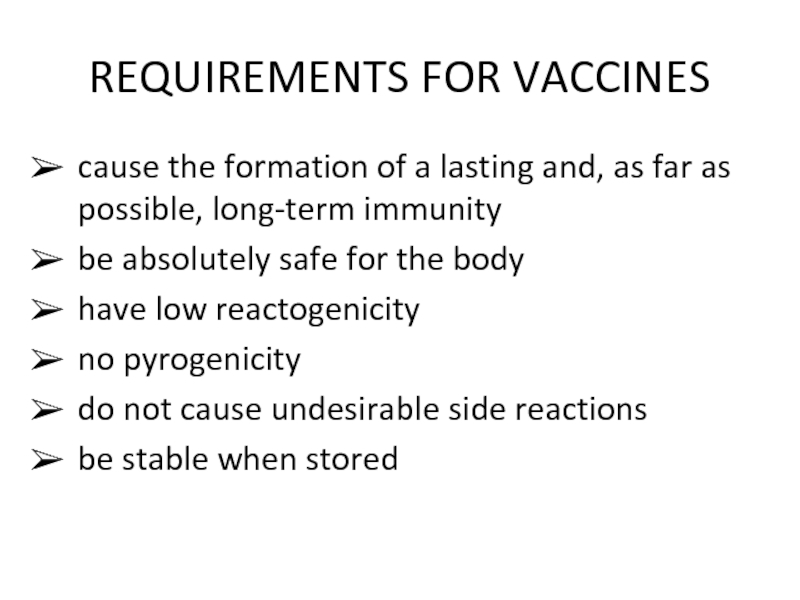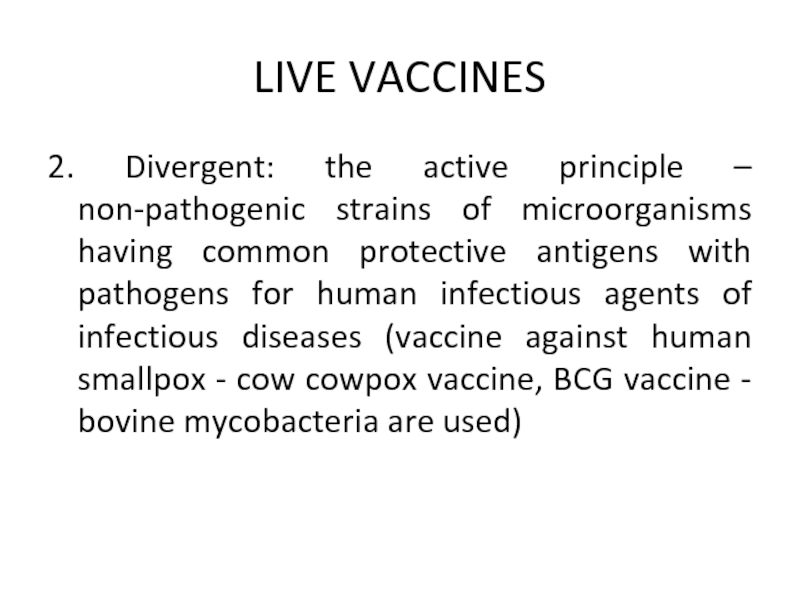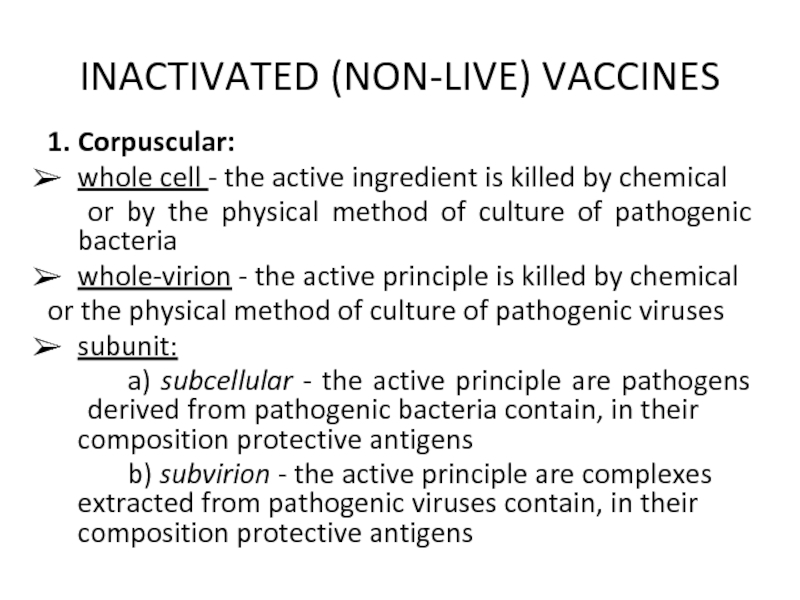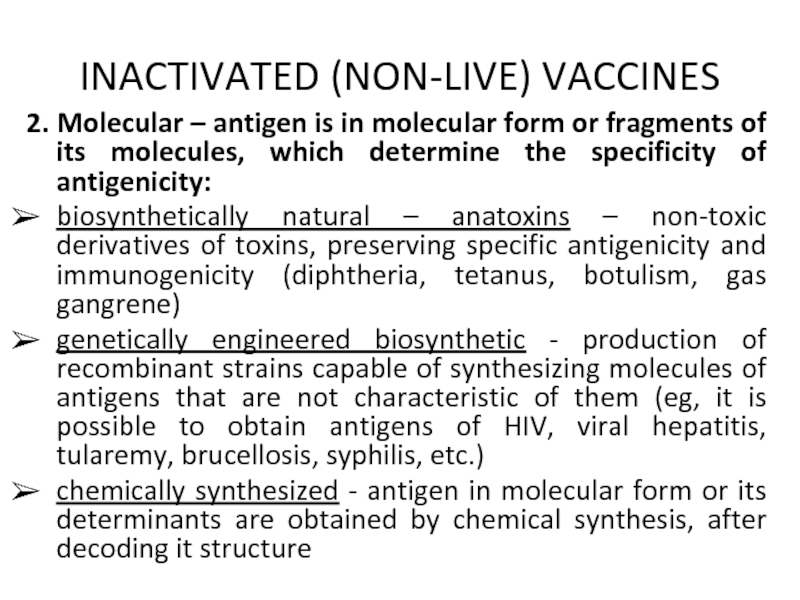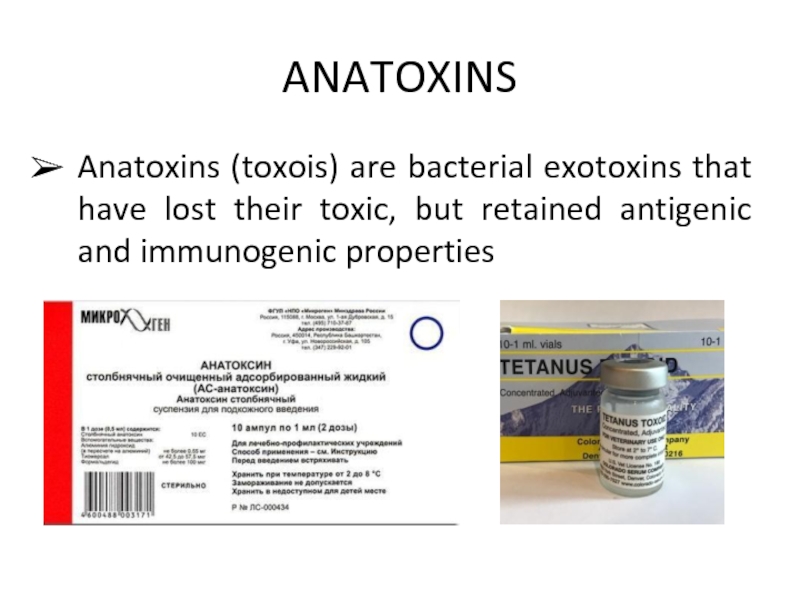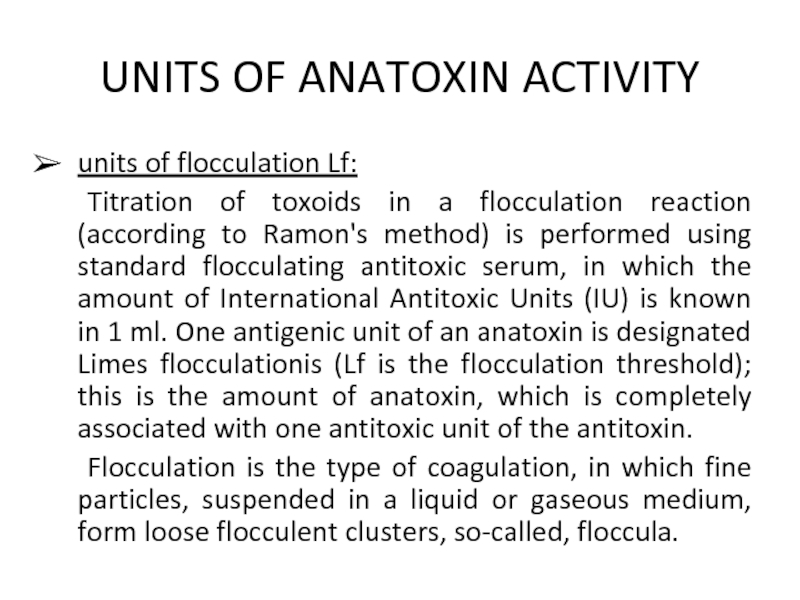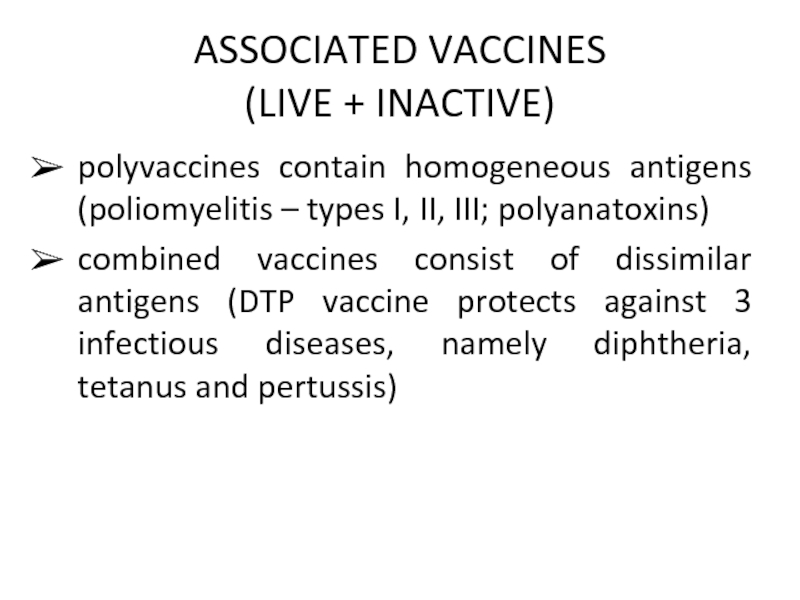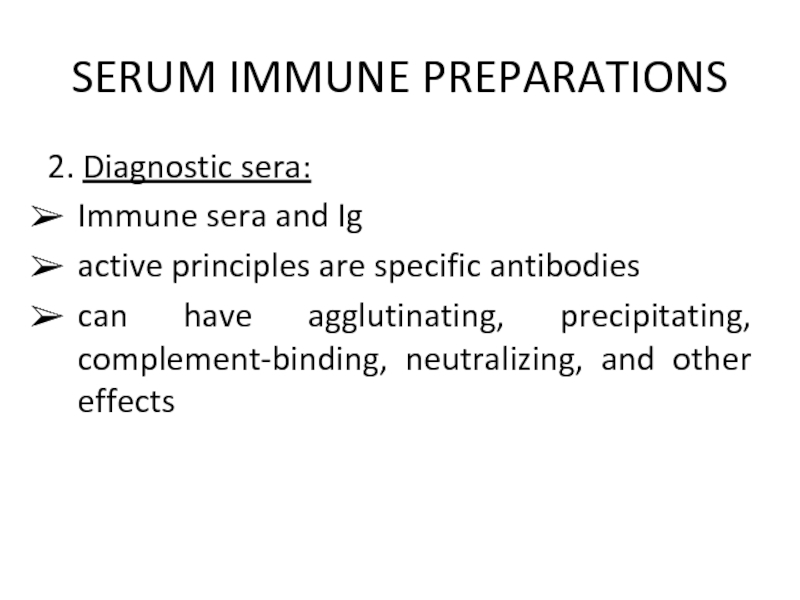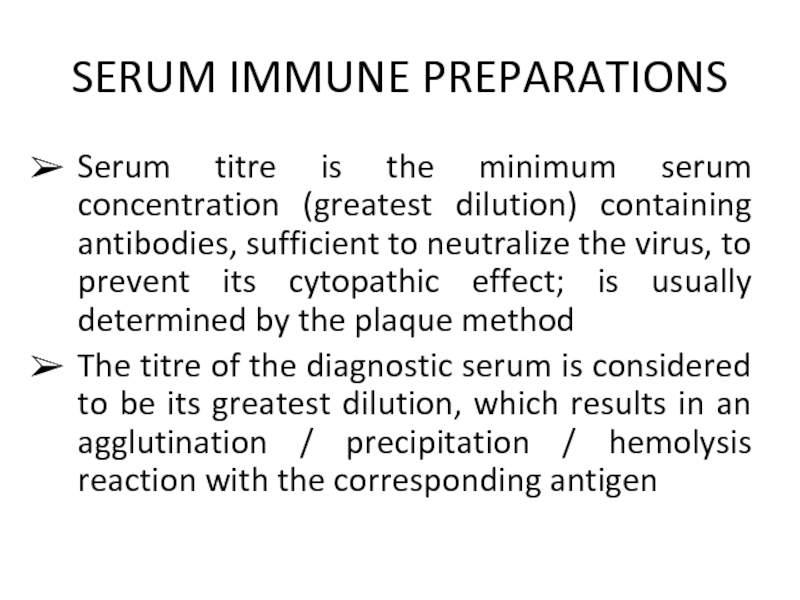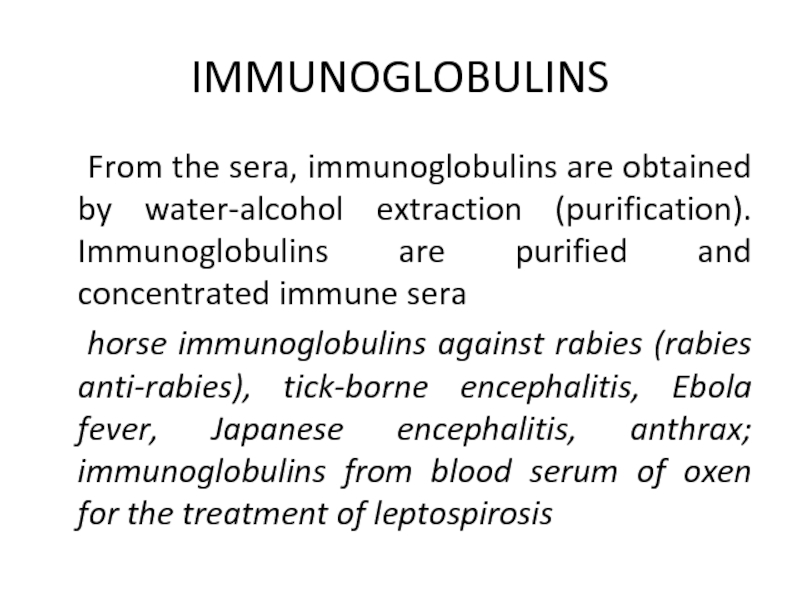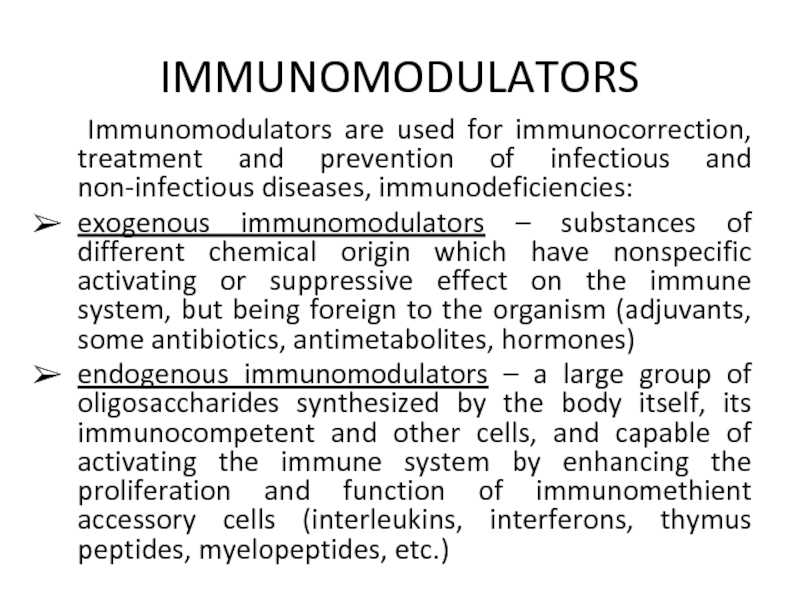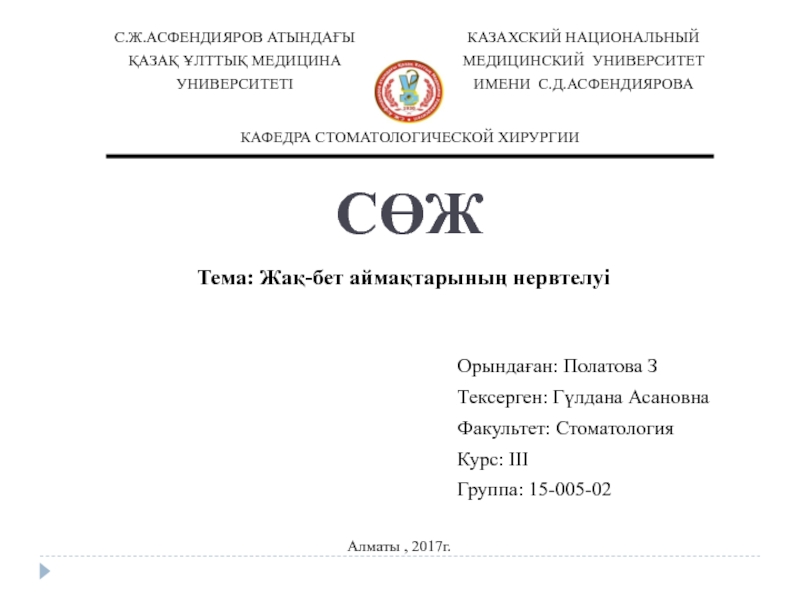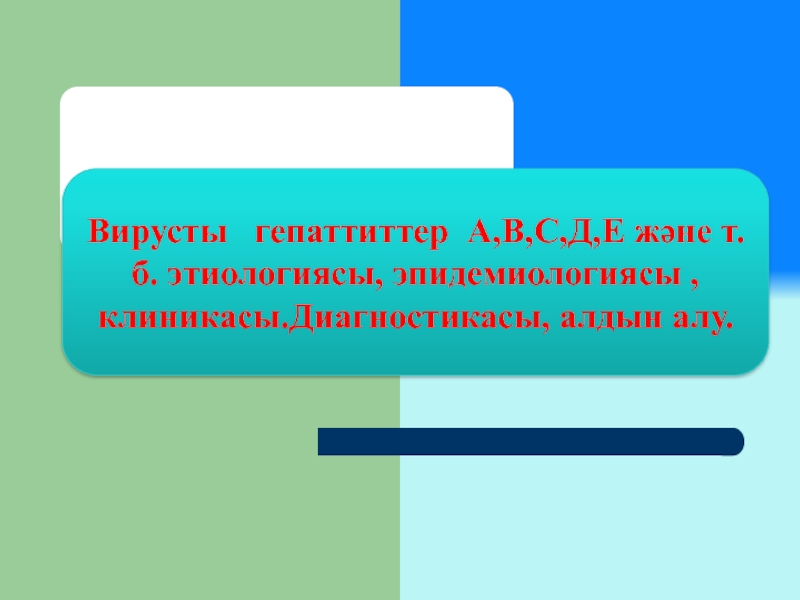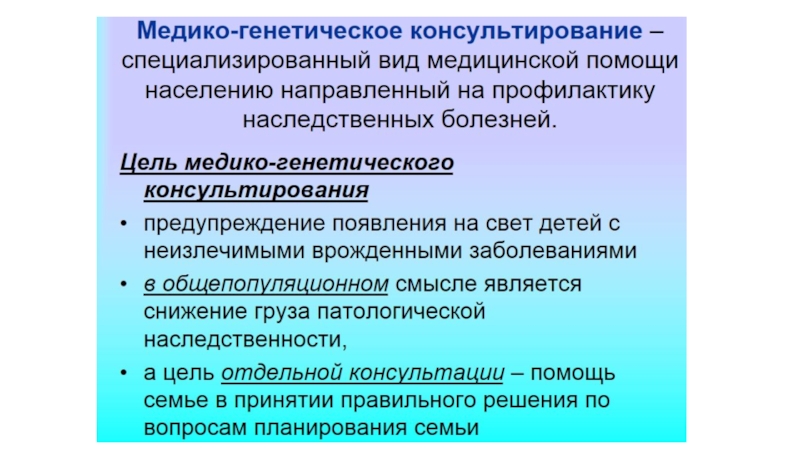- Главная
- Разное
- Дизайн
- Бизнес и предпринимательство
- Аналитика
- Образование
- Развлечения
- Красота и здоровье
- Финансы
- Государство
- Путешествия
- Спорт
- Недвижимость
- Армия
- Графика
- Культурология
- Еда и кулинария
- Лингвистика
- Английский язык
- Астрономия
- Алгебра
- Биология
- География
- Детские презентации
- Информатика
- История
- Литература
- Маркетинг
- Математика
- Медицина
- Менеджмент
- Музыка
- МХК
- Немецкий язык
- ОБЖ
- Обществознание
- Окружающий мир
- Педагогика
- Русский язык
- Технология
- Физика
- Философия
- Химия
- Шаблоны, картинки для презентаций
- Экология
- Экономика
- Юриспруденция
Immunobiological drugs презентация
Содержание
- 1. Immunobiological drugs
- 2. IMMUNOBIOLOGICAL DRUGS are effective or on the
- 3. IMMUNOBIOLOGICAL DRUGS in addition to the active
- 4. TYPES OF IMMUNOBIOLOGICAL DRUGS Preventive and medical
- 6. ARTIFICIALLY ACQUIRED IMMUNITY Artificially acquired immunity is
- 7. VACCINES are preparations used to create active
- 8. ACTIVE PRINCIPLE OF VACCINE live or inactivated
- 9. TYPES OF VACCINES ACCORDING ANTIGEN TYPES monovaccines
- 10. TYPES OF VACCINES ACCORDING ITS NATURE AND WAY OF OBTAINING Live Inactivated Recombinant
- 11. REQUIREMENTS FOR VACCINES cause the formation of
- 12. LIVE VACCINES Attenuated: the active principle –
- 13. LIVE VACCINES 2. Divergent: the active principle
- 14. LIVE VACCINES 3. Recombinant non-pathogenic for human
- 15. INACTIVATED (NON-LIVE) VACCINES 1. Corpuscular: whole cell
- 16. INACTIVATED (NON-LIVE) VACCINES 1. Corpuscular: whole cell
- 17. INACTIVATED (NON-LIVE) VACCINES 2. Molecular – antigen
- 18. ANATOXINS Anatoxins (toxois) are bacterial exotoxins that
- 19. PRODUCTION OF ANATOXINS Exotoxin synthesis by bacteria
- 20. UNITS OF ANATOXIN ACTIVITY international unit IU
- 21. UNITS OF ANATOXIN ACTIVITY units of flocculation
- 22. UNITS OF ANATOXIN ACTIVITY units of binding
- 23. ASSOCIATED VACCINES (LIVE + INACTIVE) polyvaccines
- 24. SERUM IMMUNE PREPARATIONS 1. Therapeutic and preventive
- 25. SERUM IMMUNE PREPARATIONS 2. Diagnostic sera: Immune
- 26. SERUM IMMUNE PREPARATIONS are obtained from the
- 27. SERUM IMMUNE PREPARATIONS Serum titre is the
- 28. SERUM IMMUNE PREPARATIONS heterologous (foreign) sera are
- 29. BEZREDKI METHOD is the method of desensitization,
- 30. SERUM IMMUNE PREPARATIONS are clear liquids, pale
- 31. IMMUNOGLOBULINS From the sera, immunoglobulins are obtained
- 32. IMMUNOMODULATORS Immunomodulators are used for immunocorrection, treatment
Слайд 2IMMUNOBIOLOGICAL DRUGS
are effective or on the immune system, or through the
immune system, or the mechanism their actions are based on immunological principles
have a complex composition, differ in nature, methods of production and use, to the left destination
the active principle are antigens or antibodies, or microbial cells and their derivatives, or biologically active substances such as immunocytokines, immunocompetent cells and other immunoreagents
have a complex composition, differ in nature, methods of production and use, to the left destination
the active principle are antigens or antibodies, or microbial cells and their derivatives, or biologically active substances such as immunocytokines, immunocompetent cells and other immunoreagents
Слайд 3IMMUNOBIOLOGICAL DRUGS
in addition to the active principle can include stabilizers, adjuvants,
preservatives and other substances that improve its quality (vitamins, adaptogens)
can be administered parenterally, orally, aerosolized or otherwise, so they are given the appropriate dosage form: sterile solutions and suspensions or lyophilized soluble powders for injection, tablets, aerosols, etc.
for each drug there are strictly regulated dosages and regimens, indications and contraindications, as well as side effects
can be administered parenterally, orally, aerosolized or otherwise, so they are given the appropriate dosage form: sterile solutions and suspensions or lyophilized soluble powders for injection, tablets, aerosols, etc.
for each drug there are strictly regulated dosages and regimens, indications and contraindications, as well as side effects
Слайд 4TYPES OF IMMUNOBIOLOGICAL DRUGS
Preventive and medical drugs of a microbic origin (for
example, vaccines, bacteriophages, eubiotik, anatoxins)
Medical immune drugs (for example, Ig, cytokines)
Diagnostic immune drugs (for example, antiserums), and also diagnostic bacteriophages and allergens
Immunomodulators (various synthetic drugs, biostimulators of a natural origin)
Adaptogens are complex chemical substances of the vegetable, or other origin, possessing a wide range of biological including the effect on the immune system (tissue lysates, lipids, polysaccharides, vitamins, microelements, etc.).
Medical immune drugs (for example, Ig, cytokines)
Diagnostic immune drugs (for example, antiserums), and also diagnostic bacteriophages and allergens
Immunomodulators (various synthetic drugs, biostimulators of a natural origin)
Adaptogens are complex chemical substances of the vegetable, or other origin, possessing a wide range of biological including the effect on the immune system (tissue lysates, lipids, polysaccharides, vitamins, microelements, etc.).
Слайд 6ARTIFICIALLY ACQUIRED IMMUNITY
Artificially acquired immunity is the immunity obtained through the
administration of a vaccine or immune serum.
Artificially acquired active immunity - the antigen is introduced into the vaccine (immunization), the body generates an immune response to the antigen. Immunity can be lifelong (oral polio vaccine) or temporary (tetanus).
Artificially acquired passive immunity: ready antibodies (antisera) are injected into the body. Immune serum of horses or rabbits with snake bites. Immunity is short-lived, determined by the half-life of IgG (three weeks). The human immune system does not respond to the antigen.
Artificially acquired active immunity - the antigen is introduced into the vaccine (immunization), the body generates an immune response to the antigen. Immunity can be lifelong (oral polio vaccine) or temporary (tetanus).
Artificially acquired passive immunity: ready antibodies (antisera) are injected into the body. Immune serum of horses or rabbits with snake bites. Immunity is short-lived, determined by the half-life of IgG (three weeks). The human immune system does not respond to the antigen.
Слайд 7VACCINES
are preparations used to create active artificial immunity against certain pathogens
and their toxins
are used mainly for prevention, but are sometimes used to treat infectious diseases
are obtained from bacteria, viruses, fungi, protozoa, and also from products of their vital activity
are used mainly for prevention, but are sometimes used to treat infectious diseases
are obtained from bacteria, viruses, fungi, protozoa, and also from products of their vital activity
Слайд 8ACTIVE PRINCIPLE OF VACCINE
live or inactivated microorganisms (bacteria, viruses)
antigens possessing pronounced
immunogenic properties, so-called protective antigens
the products of vital activity of microorganisms (toxins)
antigens obtained by chemical synthesis of antigens obtained with using methods of genetic engineering.
the products of vital activity of microorganisms (toxins)
antigens obtained by chemical synthesis of antigens obtained with using methods of genetic engineering.
Слайд 9TYPES OF VACCINES ACCORDING ANTIGEN TYPES
monovaccines containing the antigen of a
single serovar
polivaccines, containing antigens of several serovars
complex, combined or associated vaccines that contain antigens of several types of microorganisms, or one and the other the same species, but in different versions (for example, corpuscular and molecular antigens)
polivaccines, containing antigens of several serovars
complex, combined or associated vaccines that contain antigens of several types of microorganisms, or one and the other the same species, but in different versions (for example, corpuscular and molecular antigens)
Слайд 11REQUIREMENTS FOR VACCINES
cause the formation of a lasting and, as far
as possible, long-term immunity
be absolutely safe for the body
have low reactogenicity
no pyrogenicity
do not cause undesirable side reactions
be stable when stored
be absolutely safe for the body
have low reactogenicity
no pyrogenicity
do not cause undesirable side reactions
be stable when stored
Слайд 12LIVE VACCINES
Attenuated: the active principle – strains of pathogenic microorganisms (bacteria,
viruses) which were weakened by one way or another, have lost virulence, but have retained specific antigenicity
Слайд 13LIVE VACCINES
2. Divergent: the active principle – non-pathogenic strains of microorganisms
having common protective antigens with pathogens for human infectious agents of infectious diseases (vaccine against human smallpox - cow cowpox vaccine, BCG vaccine - bovine mycobacteria are used)
Слайд 14LIVE VACCINES
3. Recombinant non-pathogenic for human recombinant strains carrying the genes
of protective antigens of pathogenic microbes and capable of multiplying in the human body, synthesizing a specific antigen and creating immunity to the pathogen
Слайд 15INACTIVATED (NON-LIVE) VACCINES
1. Corpuscular:
whole cell - the active ingredient is killed
by chemical
or by the physical method of culture of pathogenic bacteria
whole-virion - the active principle is killed by chemical
or the physical method of culture of pathogenic viruses
subunit:
a) subcellular - the active principle are pathogens derived from pathogenic bacteria contain, in their composition protective antigens
b) subvirion - the active principle are complexes extracted from pathogenic viruses contain, in their composition protective antigens
or by the physical method of culture of pathogenic bacteria
whole-virion - the active principle is killed by chemical
or the physical method of culture of pathogenic viruses
subunit:
a) subcellular - the active principle are pathogens derived from pathogenic bacteria contain, in their composition protective antigens
b) subvirion - the active principle are complexes extracted from pathogenic viruses contain, in their composition protective antigens
Слайд 16INACTIVATED (NON-LIVE) VACCINES
1. Corpuscular:
whole cell - the active ingredient is killed
by chemical
or by the physical method of culture of pathogenic bacteria
whole-virion - the active principle is killed by chemical
or the physical method of culture of pathogenic viruses
subunit:
a) subcellular - the active principle are pathogens derived from pathogenic bacteria contain, in their composition protective antigens
b) subvirion - the active principle are complexes extracted from pathogenic viruses contain, in their composition protective antigens
or by the physical method of culture of pathogenic bacteria
whole-virion - the active principle is killed by chemical
or the physical method of culture of pathogenic viruses
subunit:
a) subcellular - the active principle are pathogens derived from pathogenic bacteria contain, in their composition protective antigens
b) subvirion - the active principle are complexes extracted from pathogenic viruses contain, in their composition protective antigens
Слайд 17INACTIVATED (NON-LIVE) VACCINES
2. Molecular – antigen is in molecular form or
fragments of its molecules, which determine the specificity of antigenicity:
biosynthetically natural – anatoxins – non-toxic derivatives of toxins, preserving specific antigenicity and immunogenicity (diphtheria, tetanus, botulism, gas gangrene)
genetically engineered biosynthetic - production of recombinant strains capable of synthesizing molecules of antigens that are not characteristic of them (eg, it is possible to obtain antigens of HIV, viral hepatitis, tularemy, brucellosis, syphilis, etc.)
chemically synthesized - antigen in molecular form or its determinants are obtained by chemical synthesis, after decoding it structure
biosynthetically natural – anatoxins – non-toxic derivatives of toxins, preserving specific antigenicity and immunogenicity (diphtheria, tetanus, botulism, gas gangrene)
genetically engineered biosynthetic - production of recombinant strains capable of synthesizing molecules of antigens that are not characteristic of them (eg, it is possible to obtain antigens of HIV, viral hepatitis, tularemy, brucellosis, syphilis, etc.)
chemically synthesized - antigen in molecular form or its determinants are obtained by chemical synthesis, after decoding it structure
Слайд 18ANATOXINS
Anatoxins (toxois) are bacterial exotoxins that have lost their toxic, but
retained antigenic and immunogenic properties
Слайд 19PRODUCTION OF ANATOXINS
Exotoxin synthesis by bacteria and removal of the microbial
bodies by filtration.
The preparation of the native toxoid is carried out according to the Ramon scheme: 0.3-1.4% formalin is added to the filtrate and kept in a thermostat at 37-400C for 4 weeks until the toxic properties completely disappear. The native toxoid is tested for sterility, harmlessness and immunogenicity.
Purification and concentration of the native toxoid.
Adsorption of anatoxin on adjuvants, mineral sorbents.
Determination of antigenic activity of anatoxin.
Determination of the immunogenic properties of an anatoxin by immunizing animals and expressed in immunizing units.
The preparation of the native toxoid is carried out according to the Ramon scheme: 0.3-1.4% formalin is added to the filtrate and kept in a thermostat at 37-400C for 4 weeks until the toxic properties completely disappear. The native toxoid is tested for sterility, harmlessness and immunogenicity.
Purification and concentration of the native toxoid.
Adsorption of anatoxin on adjuvants, mineral sorbents.
Determination of antigenic activity of anatoxin.
Determination of the immunogenic properties of an anatoxin by immunizing animals and expressed in immunizing units.
Слайд 20UNITS OF ANATOXIN ACTIVITY
international unit IU / ml: a unit for
measuring the dose of a substance based on its biological activity (is used for specific (immunogenic) activity of anatoxins in the composition of adsorbed vaccines)
Слайд 21UNITS OF ANATOXIN ACTIVITY
units of flocculation Lf:
Titration of toxoids in
a flocculation reaction (according to Ramon's method) is performed using standard flocculating antitoxic serum, in which the amount of International Antitoxic Units (IU) is known in 1 ml. One antigenic unit of an anatoxin is designated Limes flocculationis (Lf is the flocculation threshold); this is the amount of anatoxin, which is completely associated with one antitoxic unit of the antitoxin.
Flocculation is the type of coagulation, in which fine particles, suspended in a liquid or gaseous medium, form loose flocculent clusters, so-called, floccula.
Flocculation is the type of coagulation, in which fine particles, suspended in a liquid or gaseous medium, form loose flocculent clusters, so-called, floccula.
Слайд 22UNITS OF ANATOXIN ACTIVITY
units of binding UB / ml:
The amount of
anatoxin that binds 1 IU of the corresponding antitoxin is taken as 1 unit of binding (UB). The specific activity of anatoxins determined in the antitoxin binding reaction is expressed in UB / ml.
Слайд 23ASSOCIATED VACCINES
(LIVE + INACTIVE)
polyvaccines contain homogeneous antigens (poliomyelitis – types
I, II, III; polyanatoxins)
combined vaccines consist of dissimilar antigens (DTP vaccine protects against 3 infectious diseases, namely diphtheria, tetanus and pertussis)
combined vaccines consist of dissimilar antigens (DTP vaccine protects against 3 infectious diseases, namely diphtheria, tetanus and pertussis)
Слайд 24SERUM IMMUNE PREPARATIONS
1. Therapeutic and preventive sera:
Immune sera and Ig
active principles
are specific antibodies
provide passive immunity to infectious agents (antibacterial, antiviral and antifungal)
are usually administered parenterally
while the state of immunity develops rapidly, but does not last long (within 2-6 weeks)
provide passive immunity to infectious agents (antibacterial, antiviral and antifungal)
are usually administered parenterally
while the state of immunity develops rapidly, but does not last long (within 2-6 weeks)
Слайд 25SERUM IMMUNE PREPARATIONS
2. Diagnostic sera:
Immune sera and Ig
active principles are specific
antibodies
can have agglutinating, precipitating, complement-binding, neutralizing, and other effects
can have agglutinating, precipitating, complement-binding, neutralizing, and other effects
Слайд 26SERUM IMMUNE PREPARATIONS
are obtained from the blood of artificially immunized animals
and human donors (peripheral, placental and abortion blood is used for this purpose)
to obtain high titers horses and rabbits are immunized with fractional administration of corresponding antigens at high doses
to obtain high titers horses and rabbits are immunized with fractional administration of corresponding antigens at high doses
Слайд 27SERUM IMMUNE PREPARATIONS
Serum titre is the minimum serum concentration (greatest dilution)
containing antibodies, sufficient to neutralize the virus, to prevent its cytopathic effect; is usually determined by the plaque method
The titre of the diagnostic serum is considered to be its greatest dilution, which results in an agglutination / precipitation / hemolysis reaction with the corresponding antigen
The titre of the diagnostic serum is considered to be its greatest dilution, which results in an agglutination / precipitation / hemolysis reaction with the corresponding antigen
Слайд 28SERUM IMMUNE PREPARATIONS
heterologous (foreign) sera are made from animal blood contain
heterologous antibodies (administered to a person under precautionary measures – preliminary sensitivity skin test, Bezredki method, use of desensitizing agents)
horse serum against botulism, gas gangrene, diphtheria, tetanus
homologous sera are made from the blood of immunized donors contain homologous antibodies; are devoid of many side effects of heterologous sera
prevention and treatment of viral hepatitis, measles, for the treatment of botulism, tetanus, staphylococcal infections, tick-borne encephalitis, hepatitis B
After the introduction of heterologous sera, the immunity state lasts 2-3 weeks, the effect of homologous Ab persists for 4-6 weeks.
horse serum against botulism, gas gangrene, diphtheria, tetanus
homologous sera are made from the blood of immunized donors contain homologous antibodies; are devoid of many side effects of heterologous sera
prevention and treatment of viral hepatitis, measles, for the treatment of botulism, tetanus, staphylococcal infections, tick-borne encephalitis, hepatitis B
After the introduction of heterologous sera, the immunity state lasts 2-3 weeks, the effect of homologous Ab persists for 4-6 weeks.
Слайд 29BEZREDKI METHOD
is the method of desensitization, which is necessarily used to
prevent anaphylactic reactions
injecting antibacterial and antitoxic therapeutic and prophylactic sera: first 0.1-0.3 ml of serum is injected subcutaneously, and after 1-2 hours the rest of the dose
injecting antibacterial and antitoxic therapeutic and prophylactic sera: first 0.1-0.3 ml of serum is injected subcutaneously, and after 1-2 hours the rest of the dose
Слайд 30SERUM IMMUNE PREPARATIONS
are clear liquids, pale yellow in color
in ampoules
are administered
subcutaneously, intramuscularly, less commonly - intravenously or into the spinal canal
after production pass state control in accordance with the instructions of the Ministry of Health – monitoring for:
- sterility
- harmlessness
- amount of protein
- transparency and activity (antibody titer)
From the sera, immunoglobulins are obtained by water-alcohol extraction (purification). Immunoglobulins are purified and concentrated immune sera.
after production pass state control in accordance with the instructions of the Ministry of Health – monitoring for:
- sterility
- harmlessness
- amount of protein
- transparency and activity (antibody titer)
From the sera, immunoglobulins are obtained by water-alcohol extraction (purification). Immunoglobulins are purified and concentrated immune sera.
Слайд 31IMMUNOGLOBULINS
From the sera, immunoglobulins are obtained by water-alcohol extraction (purification). Immunoglobulins
are purified and concentrated immune sera
horse immunoglobulins against rabies (rabies anti-rabies), tick-borne encephalitis, Ebola fever, Japanese encephalitis, anthrax; immunoglobulins from blood serum of oxen for the treatment of leptospirosis
horse immunoglobulins against rabies (rabies anti-rabies), tick-borne encephalitis, Ebola fever, Japanese encephalitis, anthrax; immunoglobulins from blood serum of oxen for the treatment of leptospirosis
Слайд 32IMMUNOMODULATORS
Immunomodulators are used for immunocorrection, treatment and prevention of infectious and
non-infectious diseases, immunodeficiencies:
exogenous immunomodulators – substances of different chemical origin which have nonspecific activating or suppressive effect on the immune system, but being foreign to the organism (adjuvants, some antibiotics, antimetabolites, hormones)
endogenous immunomodulators – a large group of oligosaccharides synthesized by the body itself, its immunocompetent and other cells, and capable of activating the immune system by enhancing the proliferation and function of immunomethient accessory cells (interleukins, interferons, thymus peptides, myelopeptides, etc.)
exogenous immunomodulators – substances of different chemical origin which have nonspecific activating or suppressive effect on the immune system, but being foreign to the organism (adjuvants, some antibiotics, antimetabolites, hormones)
endogenous immunomodulators – a large group of oligosaccharides synthesized by the body itself, its immunocompetent and other cells, and capable of activating the immune system by enhancing the proliferation and function of immunomethient accessory cells (interleukins, interferons, thymus peptides, myelopeptides, etc.)
